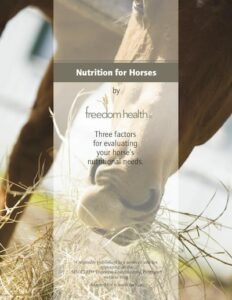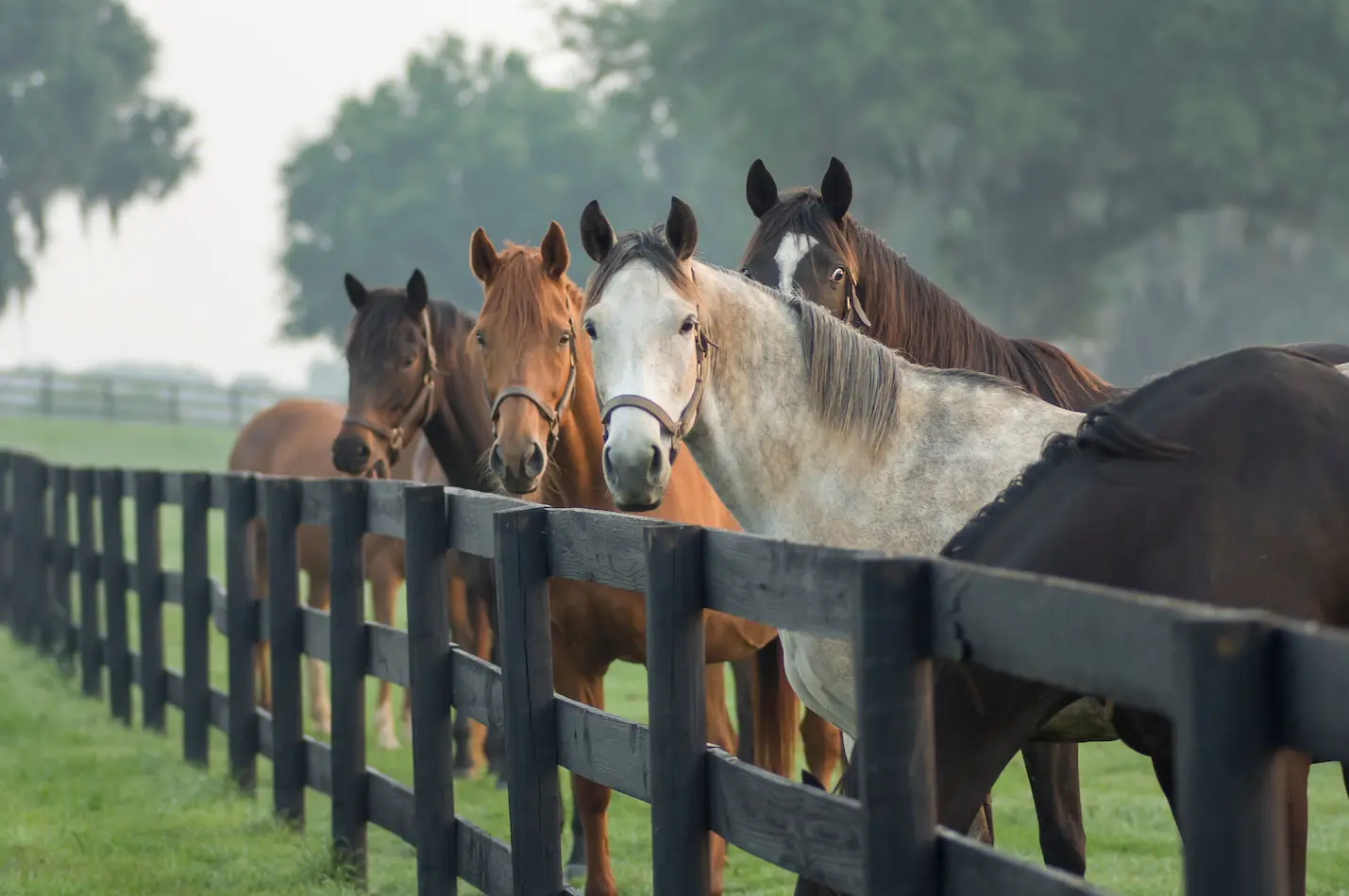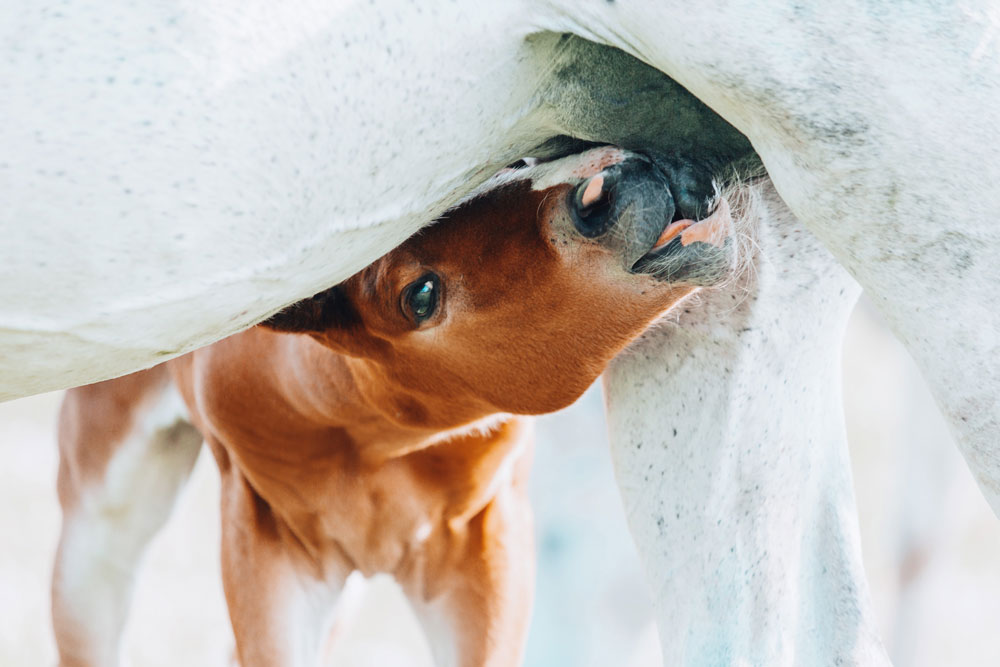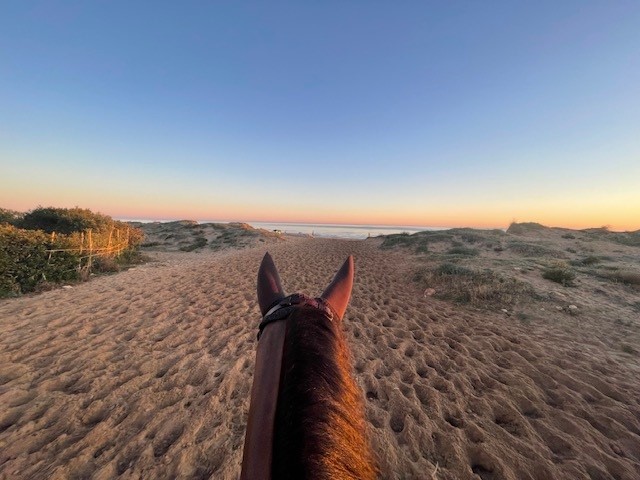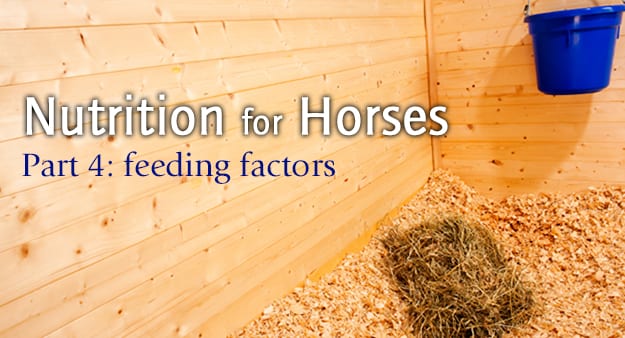 Part 4: Feeding Factors examines the role a horse’s feeding schedule and environment has on his nutrition. This series was adapted from a model introduced by the American College of Veterinary Nutrition. Subscribe to the SUCCEED blog so you don’t miss any part of this five-part series.
Part 4: Feeding Factors examines the role a horse’s feeding schedule and environment has on his nutrition. This series was adapted from a model introduced by the American College of Veterinary Nutrition. Subscribe to the SUCCEED blog so you don’t miss any part of this five-part series.
How Feeding Factors Influence Your Horse’s Nutrition
Most horse owners spend a disproportionate amount of time debating what to feed a horse. That’s important (see our last post on Dietary Factors) — but it’s equally important to assess the timing, location and amount of feed provided. As we discussed in Part 2: Horse Factors, nutritional needs vary greatly. Tools like this nutritional needs calculator from the National Research Council of the National Academies can help you estimate your horse’s needs, as can books like Nutrient Requirements of Horses, published by the NRC. A vet or equine nutritionist can also help you understand your horse’s energy requirements. Once you know what to feed, it’s important to consider how best to meet those needs.The Ideal Scenario vs. Reality
In an ideal world, horses would get all of the necessary vitamins, minerals and nutrients from naturally occurring sources. They would live outside 24 hours a day and graze slowly and constantly on a mix of grasses. However, this situation may not be realistic based on turnout restrictions, competition schedules, special dietary needs or other factors. So most horse owners supplement pasture with hay, chaff, processed feed and/or vitamins. It’s possible to design a safe and appropriate feeding regime that doesn’t rely solely on pasture grass — but it does take additional planning.Feed Management Factors: Schedule, Location and Method of Feeding
Use the ideal situation — constant access to grass — as a model, doing your best to mimic this slow and steady approach with other feeds. Here’s how:Feed Schedule
Many horse owners feed their horses twice (or maybe once) a day, providing all of the horse’s energy for the day in one or two feed dumps. This works for a human’s digestive system, but it’s nearly impossible for a horse to process that much grain-based feed at once. As a result, undigested grain can pass into the cecum and large intestine and create an overly acidic environment in the hindgut.Try This: Divide your horse’s feed into several small meals fed throughout the day. Emphasize complex carbohydrates by offering free-choice hay and adding beet pulp, chaff or other fibrous carbohydrates to his grain or pellets.
Feeding Location
Where you choose to feed your horse greatly influences his nutrition. Physical challenges (like aggressive pasture mates) may literally prevent him from eating. Emotional challenges, like a chaotic barn environment, may also create problems. He might respond by bolting his feed, or may refuse to finish it, compromising his nutrition.Try This: Move him to a quieter area where he doesn’t feel threatened. You may find that he eats more slowly and puts on weight easier when he feels comfortable enjoying his food and doesn’t have to fight for it.
Method of Feeding
How you feed a horse also plays a role in his nutrition. Never feed a horse on sandy or dusty ground, as he could ingest sand with his feed. Also avoid feeding hay on the ground if you use straw for bedding, as horses may become accustomed to eating the straw instead of the hay. While it is technically a source of forage, straw is a lower-quality food source better suited as bedding.Try This: Feed hay in hay nets, mangers or hay racks off the ground. If your horse bolts his feed, try slowly introducing your horse to doubled-up hay nets or commercial feeders to make it harder to get at. Also try to feed in an area where he has some space to move around naturally as he eats. Movement is good for gut motility (which is why horses move slowly as they graze). That doesn’t mean exercise, however — be sure to give your horse at least a 30-minute buffer between a meal and exercise. However, forage should be fed free-choice, allowing your horse to exercise with some forage present. The horse’s stomach continuously secretes acid; therefore, forage helps prevent acid from damaging the unprotected upper portion of the stomach.
Environmental Factors
Climate and temperature also influence nutrition. Rain, wind, insects and extreme temperatures reduce time spent grazing, as horses seek shelter rather than feeding. Colder weather prompts them to increase forage intake, since horses maintain body temperature by hindgut fermentation of hay. The physical landscape will also affect nutrition. Mature plants are less palatable and provide fewer nutrients, so horses may need additional supplements during the late summer. Contact your local agricultural extension office for a hay and forage evaluation.Common Feeding Mistakes
The most common issue with feeding programs is the tendency to overfeed grain-based feeds and to underfeed forage. That’s because it’s convenient, and mimics how people eat. Instead, emphasize a continuous supply of forage, where the horse has access to forage grazing at all times, even throughout the entire night. And don’t go overboard on treats, which are often loaded with sugar.Meeting Somewhere in the Middle
If the ideal model of feeding — constant grazing — doesn’t meet your horse’s energy requirements, do your best to incorporate as many aspects of this natural model into your feeding program as you can. Time, money and resources will ultimately dictate your plan, but you can always emphasize forage. Feeding SUCCEED can also help maintain a healthy digestive system and help compensate for the realities of modern horse care.Up Next: Part 5: Understanding the Horse Factors, Diet Factors and Feeding Factors that Impact your Horse’s Nutritional Needs
In our final post in this five-part series, we’ll talk about how to put your knowledge of these three factors to work in designing your own feeding program. Be sure to subscribe to the SUCCEED blog so you don’t miss any part of this series.This series was reviewed separately by two independent experts. One is a board-certified veterinary nutritionist who wishes to remain anonymous. The other is Juliet M. Getty, Ph.D. an equine nutritionist, writer, consultant and speaker. Dr. Getty currently serves as a panelist of the Equine Sciences Academy and formerly as contributing nutrition editor for Horse Journal.

